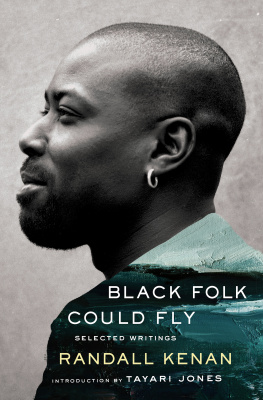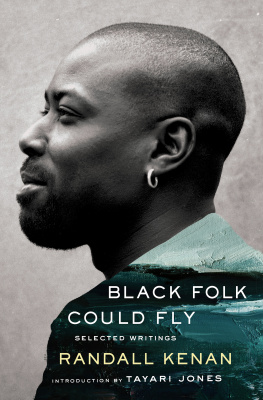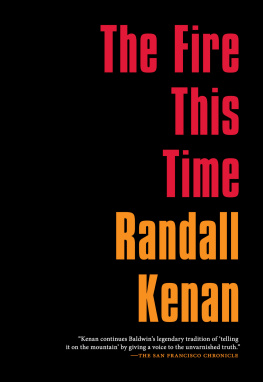
OTHER WORKS BY RANDALL KENAN
A Visitation of Spirits
Let the Dead Bury Their Dead
James Baldwin: American Writer
A Time Not Here: The Mississippi Delta
Walking on Water: Black American Lives at the Turn of the Twenty - First Century
The Fire This Time
If I Had Two Wings
BLACK
FOLK
COULD
FLY
SELECTED WRITINGS
Randall Kenan

Copyright 2022 by The Estate of Randall G. Kenan
Introduction 2022 by Tayari Jones
All rights reserved
First Edition
Since this page cannot legibly accommodate all the copyright notices, constitute an extension of the copyright page.
For information about permission to reproduce selections from this book, write to Permissions, W. W. Norton & Company, Inc., 500 Fifth Avenue, New York, NY 10110
For information about special discounts for bulk purchases, please contact W. W. Norton Special Sales at specialsales@wwnorton.com or 800-233-4830
Book design by Chris Welch
Production manager: Lauren Abbate
ISBN 978-0-393-88216-2
ISBN 978-0-393-88217-9 (ebk.)
W. W. Norton & Company, Inc., 500 Fifth Avenue, New York, N.Y. 10110
www.wwnorton.com
W. W. Norton & Company Ltd., 15 Carlisle Street, London W1D 3BS
CONTENTS
PART I
COMFORT ME
PART II
WHERE AM I BLACK?
PART III
THAT ETERNAL BURNING
Randall Kenan was an extraordinary writer and thinker, due in no small part to the fact that he was an exemplary human being. He listened as carefully as he spoke. He read even more than he wrote. He was somehow clear-eyed, yet optimistic, reverent of the past, but seldom nostalgic. He was a country boy and a man of the world. I was fortunate to know him as a mentor and friend, but if you are holding this book in your hands, then you are positioned to receive your blessing as well. These twenty-one works of nonfiction offer an experience that is like a walking expedition through a beautiful and intricate landscape, led by a tour guide who visits the popular attractions but also insists on stopping by the ancient cemeteries, telling the stories behind every stone. He will invite you to high tea, also insisting that you stop for a pulled-pork sandwich and, when you get to the pit, the man behind the grill will call him by name. Follow me , Kenan seems to say with every word, every image. I will show you the way.
For Kenan, all roads lead toor fromChinquapin, North Carolina. He was born in Brooklyn, New York, to unmarried parents, and at the age of six weeks old, he went to live with his fathers people, who gave him a legacy rich beyond measure. If you are to understand anything about Kenan, you must know this. His origin story undergoes very slight variations in each telling; the difference is in the tone rather than the substance. He was stolen away from New York. Or, his grandfather sent for him. He identifies himself as illegitimate, with irony, I believe. When he describes his grandfather as kindhearted, this is deliberate understatement. What remains constant is the fierce love and connection he feels for the family who raised him. The love shared between Kenan and his kin is enhanced by the unbidden nature of the relationship. He revels in the bond the way you might revel in finding romantic loverejoicing in the wonder and miracle of it all.
The stories of Kenans childhood signal the complexity of the man, and indeed the writer, he would become. Fans of his fiction will see the obvious likeness between the imaginary town of Tims Creek and the very real setting of Chinquapin. But in his nonfiction, we can see the ways that his remarkable early life is yellow bricks on the avenue he would travel for the rest of his days. In Chinquapin, unincorporated, and rural, largely tobacco fields and cornfields, and hog farmshe learned that identity could be kaleidoscopic, colorful, and breathtaking, like the aurora borealis he saw over his cousins house when he was eleven years old.
Imagine the boy-Randall and the seeming contradictions of his young life. He was born in the North but raised in the South. His parents were unable to care for him, but his other relatives loved him so much there was a little scuffle over who would be granted the pleasure of his custody. He was so country that one of his earliest memories was a fight with a rooster and his first glimpse into the workings of sexuality was witnessing a rendezvous between hogs. Yet in this same environment, he became an insatiable reader with a particular penchant for science fiction. Born in 1963, he lived a racially segregated life, but came to be an affirmative action baby, matriculating at the University of North Carolina.
With this rich backstory, it may seem obvious that Kenan would become a great writer. However, his early ambition was to be a scientist. Luckily (for us), a biology teacher pulled him aside. Theres no shame in being a writer, he said, gently nudging Kenan toward his destiny.
As his muse, Kenan chose Blackness, a terrain so vast, beautiful, and tangled that no writereven one as brilliant as Kenancould ever map it out. But the pleasure is in the journey. To get to the heart of Blackness as an emotional condition, Kenan mines his own family history, the stories of the dead in a neglected Richmond cemetery, the primacy of basketball, gospel, blues, the Bible, and anything else that involves humanity.
___________
For a man of Kenans generation, any quest to understand Blackness would obviously lead to James Baldwin. Despite the obvious parallels between the two menboth Black, both queer, both writersthe two stood on opposites sides of a generational and regional divide. Kenan had to learn to love the work of Baldwin, to see beyond the obvious to access their shared humanity. With Kenan, every route is circuitous and unanticipated. The highway to his fulsome appreciation of James Baldwin passes through the great Swedish filmmaker, Ingmar Bergman.
As comfortable in the cineplex as the library archives, Kenan held great appreciation for pop culture. He was especially fond of the chanteuse Eartha Kitt. While many people remember her for her trademark purr and audacious holiday ditty Santa Baby, in her Kenan saw much more. He admired her diva personawho doesnt?but remembers the day she made Lady Bird Johnson cry by speaking about the evils of racism and imperialism. On one occasion, he had the opportunity to meet the star in her dressing room and walked away with a new understanding of Southern hospitality, and Southern identity more generally.
Who would be surprised that a writer of such vast curiosity and ambition that he attempted to define Blackness would attempt the same with Southernness ? His investigation of Blackness sent him on an adventure that allowed him to meet with fascinating folks all over the country. His investigation of Southernness allowed him to eat his way across the region.
Kenan was a great student of Southern foodways. He studied in the library, reading the reflections of scholars and practitioners. But he also studied the old-fashioned waywith a napkin tucked into his collar and fork in hand. He had strong opinions about the best way to prepare barbequethough he would eat it whether it was served with or without sauce and whether that sauce was tomato-, mustard-, or vinegar-based. To him, the scuppernong is a perfect grape and one of the great cultural treasures forever lost to humanity is his great-aunts recipe for muscadine wine. From the flavor of that wine, harsh, sweet, and bracing, he learned one of lifes great lessons: You dont drink life because its good for you, you drink life because its good.
Next page














